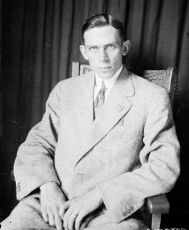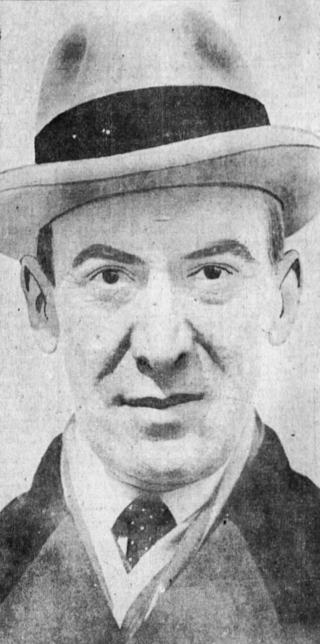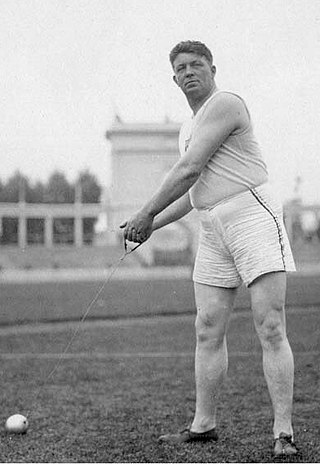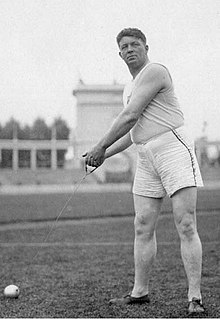
Melvin Whinfield "Peerless Mel" Sheppard was an American athlete, member of the Irish American Athletic Club, and winner of four gold medals and one silver medal at the 1908 Summer Olympics and 1912 Summer Olympics. Along with Henry Taylor of the United Kingdom, he was the most successful athlete at the 1908 Olympics.

John Joseph Hayes was an American athlete, a member of the Irish American Athletic Club, and winner of the marathon race at the 1908 Summer Olympics. Hayes' Olympic victory contributed to the early growth of long-distance running and marathoning in the United States. He was also the first man to win a marathon at the now official standard distance of 26 miles 385 yards when Olympic officials lengthened the distance to put the finish line in front of the Royal Box.

Paul McGrath is an Irish former professional footballer, who played as a defender. McGrath is widely considered to be one of the greatest defenders of all time and was known by the nickname 'God' at Aston Villa. Mainly a centre back, he also played as defensive midfielder. He spent the majority of his career at Villa and Manchester United. He is one of only six defenders to have won the PFA Players' Player of the Year award. He also played for St Patrick's Athletic, Derby County and Sheffield United.

William Patrick "Parry" O'Brien was an American shot put champion. He competed in four consecutive Summer Olympics where he won two gold medals and one silver medal (1960). In his last Olympic competition (1964) he placed fourth. For all of these accomplishments, O'Brien was inducted into the IAAF and U.S. Olympic halls of fame.

Matthew John McGrath was a member of the Irish American Athletic Club, the New York Athletic Club, and the New York City Police Department. At the time of his death at age 64, he attained the rank of Police Inspector, and during his career received the NYPD's Medal of Valor twice. He competed for the U.S. team in the Olympics in 1908, 1912, 1920 and 1924. In his prime, he was known as "one of the world's greatest weight throwers."

Martin John Sheridan was a three time Olympic Games gold medallist. He was born in Bohola, County Mayo, Ireland, and died in St. Vincent's Hospital in Manhattan, New York, the day before his 37th birthday, a very early casualty of the 1918 flu pandemic. He is buried in Calvary Cemetery, Queens, New York. He was part of a group of Irish-American athletes known as the "Irish Whales".

John Joseph Flanagan was an Irish-American three-time Olympic gold medalist in the hammer throw, winning in 1900, 1904, and 1908.

The men's hammer throw was one of six throwing events on the Athletics at the 1908 Summer Olympics programme in London. The competition was held on July 14, 1908. 19 throwers from eight nations competed. NOCs could enter up to 12 athletes. The event was won by American John Flanagan, his third consecutive victory in the event. He was the first man to win three medals in the hammer throw and, as of the 2016 Games, the only one to win three gold medals in the event. The silver medal went to fellow American Matt McGrath. Con Walsh of Canada took bronze and became the first athlete not from the United States to win a medal in the event, as the Americans had swept the podium in both 1900 and 1904. The three medalists were all part of the Irish Whales.

Lawson "Robbie" N. Robertson was considered one of the more accomplished American track coaches of the first half of the twentieth century. From 1904-1936, he was with the American team at every Olympics with the exception of 1916 when the Olympics were cancelled due to WWI. He coached Track and Field for the Irish-American Athletic Club in Queens, New York from 1909–16, and then for the University of Pennsylvania from 1916-47. He was U.S. Olympic Assistant Track coach in 1912 and 1920 and was head coach for the American Track and Field Team in four Olympics from 1924-36.

John Joseph Daly was an Irish runner who won a silver medal in the steeplechase at the 1904 Summer Olympics. He competed for Ireland at the International Cross Country Championships of 1903–1906 and won two silver team medals; individually he won a bronze in 1903 and finished fourth in 1904 and 1906. When not competing for Ireland as a member of the Gaelic Athletic Association, Daly entered races as a member of the Irish American Athletic Club.
Cornelius Edward "Con" Walsh was an Irish Canadian athlete who represented Canada at the 1908 Summer Olympics. He was born in Carriganimma. He won a bronze medal in the hammer throw, finishing third behind fellow Irishmen John Flanagan and Matt McGrath, both of whom represented the United States. Another Irishman, Robert Kerr also represented Canada at the same games. Walsh had earlier played Gaelic football and represented Cork.

Patrick Joseph McDonald was born in Doonbeg, County Clare, Ireland. He competed as an American track and field athlete in a variety of the throwing events. He was a member of the Irish American Athletic Club and of the New York City Police Department, working as a traffic cop in Times Square for many years. He was part of a group of Irish-American athletes known as the "Irish Whales."

Patrick James Ryan was an Irish American hammer thrower. He competed for the United States at the 1920 Summer Olympics and won a gold medal in the hammer throw and a silver in the 56-pound weight throw. In 1913 he established the first world record in the hammer throw, which stood as a world record for 25 years and as an American record for 40 years. Ryan was part of Irish weight throwers known as the Irish Whales.

The men's hammer throw was a track and field athletics event held as part of the athletics at the 1912 Summer Olympics programme. It was the fourth appearance of the event, which had been won all three previous times by John Flanagan. The competition was held on Sunday, July 14, 1912. Fourteen hammer throwers from four nations competed. NOCs could enter up to 12 athletes. The event was won by Matt McGrath of the United States, the nation's fourth consecutive victory in the event. McGrath was the second man to earn multiple medals in the hammer throw. Duncan Gillis of Canada took silver. Clarence Childs of the United States finished third for bronze.
John Hugh Gillis was the first person to walk across Canada, and became Canadian all-round champion of track and field, now called the decathlon.

Simon Peter Gillis was an American track and field athlete, a member of the New York Athletic Club, and the New York City Police Department. He was one of a group of athletes known as the Irish Whales and frequently kept company with members of the Irish American Athletic Club. He competed in weight throwing events in the 1904, 1908 and 1912 Summer Olympics.

The Irish American Athletic Club was an amateur athletic organization, based in Queens, New York, at the beginning of the 20th century.
Tom McGrath is an Irish-American ultra-runner. He has run over 200,000 miles to raise money for charities. Due to his 1977 run across America and other accolades, he has been nicknamed The Irish Forrest Gump.

Atle Lie McGrath is a Norwegian World Cup alpine ski racer, a member of the Norwegian Alpine Ski Team. He gained his first World Cup podium in December 2020 in a giant slalom at Alta Badia, Italy, and his first win in March 2022 in slalom at Flachau, Austria.

















